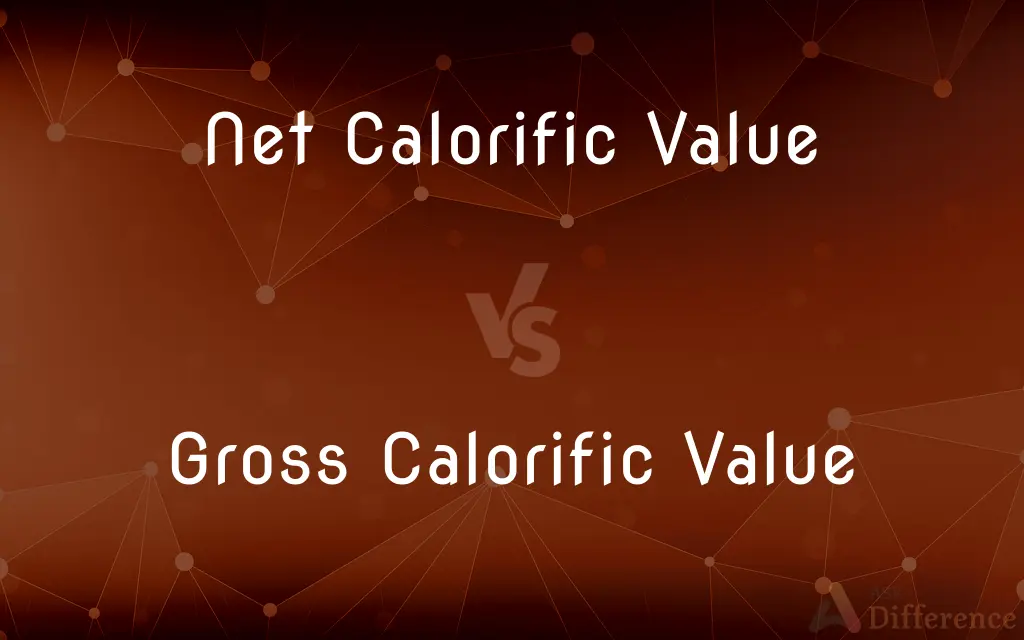Net Calorific Value vs. Gross Calorific Value — What's the Difference?
By Tayyaba Rehman — Published on November 19, 2023
Net Calorific Value (NCV) measures energy excluding latent heat from vaporized water, while Gross Calorific Value (GCV) includes all energy, even from vaporized water.

Difference Between Net Calorific Value and Gross Calorific Value
Table of Contents
ADVERTISEMENT
Key Differences
The Net Calorific Value and Gross Calorific Value are both measures used to determine the energy content of fuels. The essential difference lies in what each considers when measuring energy.
Net Calorific Value (NCV) provides the amount of energy a fuel can produce, excluding the energy used to vaporize water. In essence, it represents the "usable" energy from the fuel. When fuels burn, they often produce water vapor, which consumes some energy to produce.
On the other hand, Gross Calorific Value (GCV) considers all the energy content of the fuel, even the energy that's used to produce water vapor. This means GCV typically yields a higher value than NCV because it accounts for all energy, both usable and that consumed in water vaporization.
In conclusion, while both Net Calorific Value and Gross Calorific Value provide insights into the energy content of fuels, they differ in the specific energy components they account for. NCV provides a more realistic measure of usable energy, whereas GCV gives a total energy count.
Comparison Chart
Components Considered
Excludes energy for water vaporization
Includes all energy
ADVERTISEMENT
Value Typically
Lower than GCV
Higher than NCV
Reflects
Usable energy from fuel
Total energy content of fuel
Importance
Useful in real-world applications
Important for theoretical calculations
Influenced By
Fuel type, moisture content
Fuel type, total energy content
Compare with Definitions
Net Calorific Value
"Usable" energy determination from a fuel.
Engineers often rely on Net Calorific Value for designing heating systems.
Gross Calorific Value
Total energy content measurement of fuel.
The Gross Calorific Value gives the maximum potential energy of coal.
Net Calorific Value
Energy after subtracting latent heat.
Dry wood has a higher Net Calorific Value than damp wood.
Gross Calorific Value
Includes energy used in water vaporization.
Fuels with more moisture might have a higher Gross Calorific Value but lower usable energy.
Net Calorific Value
Realistic energy measure for applications.
To ensure efficiency, manufacturers might reference the Net Calorific Value.
Gross Calorific Value
Comprehensive energy measure for theoretical work.
Researchers might study Gross Calorific Value for in-depth fuel analyses.
Net Calorific Value
Derived from GCV after accounting for vaporized water.
The Net Calorific Value can be calculated using specific formulas from the GCV.
Gross Calorific Value
Energy value before subtracting latent heat.
The Gross Calorific Value remains constant for a specific fuel type.
Net Calorific Value
Energy measure excluding water vaporization energy.
The Net Calorific Value of coal may vary based on its moisture content.
Gross Calorific Value
Represents the upper limit of energy in fuel.
Knowing the Gross Calorific Value helps in understanding a fuel's potential.
Common Curiosities
Does the Gross Calorific Value change with moisture content?
While Gross Calorific Value remains consistent for a fuel type, moisture content affects usable energy.
What does the Net Calorific Value represent?
The Net Calorific Value represents the usable energy from a fuel, excluding water vaporization energy.
Why is the Net Calorific Value important for engineers?
Engineers use the Net Calorific Value to design systems based on usable energy.
What happens to the Gross Calorific Value when moisture increases?
The Gross Calorific Value remains consistent, but the usable energy (NCV) may decrease.
Can the Net Calorific Value be derived from the Gross Calorific Value?
Yes, the Net Calorific Value can be calculated using the Gross Calorific Value and subtracting latent heat.
Which value is more practical for daily use, NCV or GCV?
Net Calorific Value is more practical as it represents usable energy.
Are both NCV and GCV measures standardized?
Yes, both Net Calorific Value and Gross Calorific Value have standardized measurement techniques.
Can different fuels have similar Gross Calorific Values?
Yes, different fuels can have similar Gross Calorific Values, but their NCVs may differ.
Is the Gross Calorific Value always higher?
Yes, the Gross Calorific Value is typically higher as it includes all energy content.
Why is water vaporization considered in GCV?
Gross Calorific Value aims to give a comprehensive energy measure, so it includes all energy components.
Which value is more theoretical in nature, NCV or GCV?
The Gross Calorific Value is more theoretical, representing total energy potential.
Does burning efficiency affect the Gross Calorific Value?
No, burning efficiency affects the energy realized, but the Gross Calorific Value of the fuel remains constant.
Which is more important for environmental considerations?
Both are important, but the Net Calorific Value often gets more attention due to its practical implications.
Can I compare two fuels using their NCV?
Yes, comparing the Net Calorific Values of two fuels can give insights into their usable energy.
How can I increase the Net Calorific Value of a fuel?
Reducing moisture content can help in increasing the Net Calorific Value of certain fuels.
Share Your Discovery

Previous Comparison
Thank You vs. Thanks
Next Comparison
Tungsten Carbide vs. Boron CarbideAuthor Spotlight
Written by
Tayyaba RehmanTayyaba Rehman is a distinguished writer, currently serving as a primary contributor to askdifference.com. As a researcher in semantics and etymology, Tayyaba's passion for the complexity of languages and their distinctions has found a perfect home on the platform. Tayyaba delves into the intricacies of language, distinguishing between commonly confused words and phrases, thereby providing clarity for readers worldwide.
















































